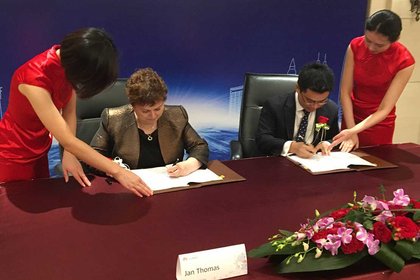
Professor Thomas signs the agreement alongside Huawei New Zealand chief executive officer Yanek Fan.
Massey University has a multi-million dollar deal with one of the world’s leading information and communications providers, Huawei, to upgrade the wireless infrastructure on its three campuses to cope with growing demand from students.
Vice-Chancellor Professor Jan Thomas signed the deal in Shenzhen, China, late last month. It followed a tender process and several months of negotiation. Huawei will provide the hardware and design and install the network.
Assistant Vice-Chancellor Strategy, Finance, IT and Commercial Operations Cathy Magiannis, who accompanied Professor Thomas, says Massey is committed to providing a first-class digital experience for students and the deal with Huawei lays the foundations to continue delivering on this commitment.
“Our network can currently accommodate around two devices per user,” Mrs Magiannis says. “However, our research into future trends suggests we need to be able to service three – or potentially even four – devices per user.”
Quality, as well as quantity, is an issue, she says, citing film and television streaming service Netflix as an example. “When you consider devices are increasingly streaming in ultra-high-definition, where before they were using high-definition.”
Ms Magiannis credits the University’s procurement team with sourcing a solution to its wireless and network requirements that meets or exceeds Massey’s needs at a very competitive cost.
Huawei will upgrade the University’s core, distribution and access switches in order to increase network traffic capacity and establish the foundation for software-defined networking (SDN).
“SDN means our IT team can be far more flexible in the provisioning of the University’s IT network. In particular, we will be able to deliver software updates, or ‘patches’, from a central remote location, rather than members of the team having to physically update hardware configurations.”
She says upgrades to the University’s wireless network will be completed within two years.